Replacing a worn or broken engine on a customer’s vehicle can be a very sensitive subject for many independent shop owners because it’s a time-intensive and possibly high-liability service. After a replacement is done, a shop’s greatest fear is that a minor ticking noise or oil leak may ruin the profitability of the engine replacement. Nevertheless, engine replacements can be profitable, providing that the service is priced at a profitable level and that the correct precautions are taken to prevent expensive comebacks.
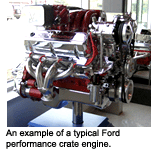 Power Options
Power Options
An independent repair shop has a handful of engine replacement options available: a used engine, a quality rebuilt, a remanufactured or new OE engine.
When choosing between the used, rebuilt, remanufactured and OE-“crate” engine options, always remember that a used engine might, for example, routinely require an expensive timing chain and guide replacement. However, due to the inherent reliability of some import engines, many nameplate shops feel safe in choosing a used engine as a replacement option.
Remanufactured engines are a mixed bag, largely dependent upon core availability, the quality of the OE castings and the quality controls associated with the remanufacturing process itself. As for new “crate” engines, the expense usually eliminates this option for some customers. In some cases, however, the new engine may perhaps be the safest, most reliable option.
One of the many factors involved in choosing an engine are the expectations of the customer, which may include the cost, reliability and durability of the engine replacement. Although the value of the engine replacement may exceed the value of the vehicle, replacing an engine makes good economic sense if the vehicle is in above-average condition or has some other redeeming virtue. In most cases, it’s simply tossing good money down the drain to install an engine in a worn-out chassis. As always, replacing a worn or broken engine is as much of a subjective, as it is a financial, judgment.
Causes of Engine Failure
Most engines usually fail due to overheating or under-lubrication. A leaking water pump or hose, a clogged radiator, an inoperative fan system, a stuck thermostat or a blown cylinder head gasket may cause overheating. In some instances, a blown cylinder head gasket might be the result of overheating rather than a mechanical failure in the gasket itself. In some rare instances, loading and driving the vehicle beyond its rated capacity may cause overheating.
Conversely, under-lubricated engines may be the victims of an oil leak or neglect. Although oil leaks are rather obvious, driving a vehicle without checking the oil or without changing it at scheduled intervals implies owner neglect.
An engine with a heavily sludged lubricating system usually suffers from premature wear and, occasionally, catastrophic bearing failures caused by clogged oil pump screens or oil galleries. Heavily sludged engines may also tend to have application-specific lubricating problems in some areas of the engine, including valve and camshaft oiling. Insufficient oiling, on the other hand, often results in the overhead camshaft seizing in the cylinder head, the timing belt breaking, and interfering intake and exhaust valves bending. Insufficient oiling also may cause crankshaft damage and severe piston scuffing.
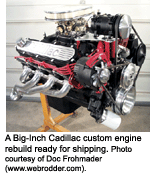 Money Talk
Money Talk
Many shops lose money because they estimate a partial, rather than a complete, engine replacement. Under-estimating the engine replacement usually causes the shop to write off many billable hours in order to resolve these otherwise avoidable misunderstandings with the customer.
Since a replacement engine is usually priced at a very low profit margin, and considering the warranty liability, the long installation times and other contingencies that go along with an engine replacement, profitability can be very low or, in some cases, non-existent. The true profit in an engine replacement is found in the add-on items required to restore the engine support systems and drivetrain to like-new performance.
For example, during the estimating process, extra time should be included for cleaning parts, removing broken studs, refinishing warped manifolds and road-testing the finished product. In addition, a wheel alignment should be included if the front suspension is disassembled or the engine cradle is removed during the replacement process.
When estimating an engine replacement, it’s important to remember that oxygen sensors may be contaminated with antifreeze or oil from the old engine. If the old engine was severely overheated, it’s a safe bet that the calibration on the temperature gauge and engine management coolant sensors has also been ruined. Along the same lines, don’t forget that new spark plugs, wires and, if applicable, distributor cap and rotor are recommended, especially if the engine is a 1995 or newer model equipped with an OBD II misfire monitor. The catalytic converter also may be ruined from a misfire condition or contaminated with antifreeze or oil, so it’s wise to leave the estimate open for such contingencies, especially when operating in an area that requires an annual emissions test.
When the intake manifold is removed, the exhaust gas recirculation (EGR) passages should be cleaned to make sure that the EGR flow is adequate and distributed evenly among the cylinders. If this basic procedure isn’t performed, the on-board diagnostics may later discover the fault, store an EGR failure code and illuminate the Check Engine or Malfunction Indicator Light.
Other Pricing Notes
Be sure to include expendable items like timing belts, drive belts and tensioner pulleys in the estimate. Many reman engines, for example, are shipped without timing belts. If the engine is used, a timing belt replacement is recommended, especially with the engine out of the chassis. If the engine is a valve interference type, a technician simply can’t afford not to replace the timing belt with a fresh unit simply because of warranty considerations.
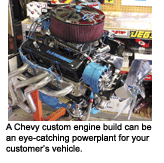 Also, if the old engine has suffered catastrophic bearing failure and is equipped with an engine oil cooler, the probability is very high that the cooler itself is heavily contaminated with metal particles. The best option is to replace the oil cooler to avoid ruining the new engine.
Also, if the old engine has suffered catastrophic bearing failure and is equipped with an engine oil cooler, the probability is very high that the cooler itself is heavily contaminated with metal particles. The best option is to replace the oil cooler to avoid ruining the new engine.
Cooling System Considerations
Cooling system component sales usually are neglected because a shop is trying to keep the cost of an engine replacement affordable. While it’s true that every job has to balance affordability with reliability, it’s also true that a clogged radiator, badly deteriorated hoses or a worn water pump can cause the new engine to overheat and possibly fail. Radiators are always a prime candidate for service or replacement, since the old engine may have been overheated. When overheating occurs, sediment from the engine’s water jackets may partially clog the radiator core, which reduces the cooling capacity of the radiator. While this condition may not be obvious at first, it may come back to haunt the engine installer on a hot summer day. In the extreme case, the engine replacement may be ruined, especially if the driver doesn’t keep an eye on the temperature gauge.
At the very minimum, the radiator should be cleaned externally and flushed before doing the engine installation. In addition, the correct mix of factory-recommended coolant should be installed to ensure against the coolant boiling away or a freeze-up occurring during the cold days of winter.
After the new engine is thoroughly warmed up, always make sure the engine cooling fan(s) activate when the coolant approaches specified maximum outlet temperature. In some cases, the cooling fan may have two speeds, with the slower speed activating when a normal temperature increase occurs, and the second speed activating when the coolant temperature exceeds a specific threshold or when the air conditioning is turned on. When all systems are “up and running,” the complete engine replacement is ready to roll out the door with your full confidence that it will perform to the original manufacturer’s specifications.
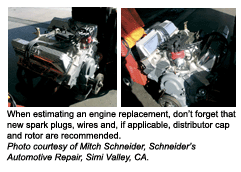 Block Prep
Block Prep
Engine blocks are generally resistant to heat and lubrication damage. More commonly, an engine block might develop fatigue cracks between cylinders or around main bearing journals, which renders the block unserviceable. A worst-case scenario might include spun main bearings, which requires the main bearing journals to be align-bored.
Unfortunately, align-boring, like excessive block and head milling, reduces centerline dimension between the crank and camshafts, which retards camshaft timing.
Although over-boring the cylinders can cause overheating and excessive oil consumption, most remanufacturers now hone the cylinders to accommodate piston oversizes amounting to much less than the standard 0.030” oversize bore.
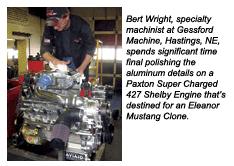 Torque plating, which duplicates the stresses and distortions in the cylinders caused by tightening the cylinder head to the engine block, involves installing a heavy plate resembling a cylinder head gasket to the engine block. Torque plating is critical for correct cylinder refinishing on some engines that use low-tension piston rings.
Torque plating, which duplicates the stresses and distortions in the cylinders caused by tightening the cylinder head to the engine block, involves installing a heavy plate resembling a cylinder head gasket to the engine block. Torque plating is critical for correct cylinder refinishing on some engines that use low-tension piston rings.
The most common oversight in cylinder block preparation is the failure to remove hardened accumulations of core sand and sludge in the cylinder block water jackets, which can cause future overheating and radiator clogging problems.
Eliminate Factors for Comebacks
When completing an engine swap, remember to include new coolant hoses, drive belts, clutch and hydraulic linkage assembly, spark plugs, ignition wires, fuel and air filters, and similar “wearing” items in the engine replacement estimate. In all cases, the customer is saving on installation costs. More to the point, the majority of warranty headaches and customer misunderstandings can be reduced by simply replacing components that have a limited service life.
|
TECH Q & A
Q: At what point should an engine be replaced? A: When it is more economical to replace it than repair it. Today’s engines are built to last 150,000 miles or more. Most engines can go the distance with proper maintenance. Without regular oil and filter changes, the engine will suffer oil sludging, loss of lubrication and internal damage long before it reaches the end of its intended service life. Several forces are at work to shorten engine life. One is leasing. People (and fleets) who lease new cars and trucks tend to skimp on maintenance because they know they’re not keeping the vehicle more than 12, 24 or 36 months. Consequently, the second owner often suffers the consequences of the first owner’s neglect. Extended oil change intervals of 7,500 miles or longer that are recommended by some vehicle manufacturers to reduce maintenance costs are also causing many late-model engines to fail prematurely. Changing the oil and filter every 3,000 miles or three to six months is still the best advice for most motorists. Even with proper maintenance, all engines eventually wear out. Rings, bearings and cylinders wear. Timing chains, gears and oil pumps wear. Timing belts can break. Camshafts, lifters and valve guides wear. Valve springs lose tension. Gaskets and seals can start to leak. If an engine loses its supply of coolant because of a leaky water pump, radiator or hose failure, or the thermostat sticks shut, the engine may overheat and crush a head gasket, scuff a piston or crack a cylinder head. Today, any damage that requires internal engine repairs can often cost as much in parts and labor as replacing the entire motor with a remanufactured engine. Replacing the original engine can provide years of additional use from an existing vehicle, and can save the owner the expense of having to purchase a replacement vehicle and make higher monthly payments. People are keeping their vehicles longer than ever before today, and many are “upside down” as to what they owe on their vehicles and what it is worth to sell or trade — especially if it has a bad engine. It is probably time to replace an engine if (1) it is using more than a quart of oil every 1,000 miles, (2) it is misfiring because of oil-fouled spark plugs or loss of compression in one or more cylinders, or (3) it has unusually low oil pressure and/or is making knocking or rattling noises that indicate bearing wear. If an engine has seized, it has reached the end of the road and must be replaced. Q: What’s a “crate” engine? A: A crate engine is a new or remanufactured engine that comes in a crate, assembled and ready to install. You can get stock crate replacement engines or upgrade to a performance crate engine and choose almost any horsepower level from mild to wild. A typical crate engine comes with the heads and intake manifold mounted on the block. Some may even include a new carburetor or injectors. Crate engines have become a popular alternative to overhauling or custom rebuilding engines because of the cost savings and convenience they offer. There’s no waiting for back-ordered parts to arrive or machine work to be finished, there are no unpleasant surprises and the engine is ready to go. Most crate engines are backed by a warranty and have been pre-tested to assure quality and performance. One of the reasons why crate engines are selling so well today is because machine shop labor has become so expensive. Every job that requires machine work and handling adds cost to overhauling or repairing an engine. Overhauling an engine involves tearing the old engine apart, cleaning everything, inspecting the block, heads and parts for cracks, wear and damage, replacing anything that is worn and can’t be reused, remachining the block, heads and crankshaft, and finally reassembling the engine. It’s much more economical for engine builders to do this kind of work on a production line than to do individual jobs on a piecemeal basis. There are a lot of unknowns when overhauling an existing engine. The block, heads or crank may be too badly worn or damaged to be reused, or these parts may require a lot of expensive reconditioning (such as sleeving the block or boring the cylinders to oversize and replacing the original pistons with oversized pistons). Aluminum overhead cam heads are often cracked or warped, and require welding and straightening — if they can be salvaged at all. With a crate engine, there are no such surprises and the cost is fixed. Crate engines also are a good way to provide a performance upgrade to a customer. Although performance-based domestic crate engines have been around for a while, much of the growth today is being seen with import engines. There’s several companies out there that now offer preassembled Honda and Mitsubishi crate engines that are built to give your customer 270 to 300 hp right out of the box. Crate engines like these typically retail for $10,000 to $12,000 and come with a 12-month, 12,000-mile warranty. Most crate engines are sold outright, so there are no exchange hassles (plus the old engine can be sold to someone else if it’s still good). And there’s no risk of misassembly because the engine comes assembled, pre-tested and ready-to-install. All you have to do install the intake plumbing, ignition system and exhaust, and do the final tuning. Q: What are the most common installation mistakes when replacing an engine? A: Not priming the oil system before cranking the engine, or forgetting to fill the crankcase with oil. A dry start will ruin any engine in a hurry. Other common mistakes include not getting the cooling system properly filled (air pockets lead to overheating), misrouted vacuum hoses and wiring, leaving ground straps off — and not diagnosing and correcting pre-existing conditions that may have caused the original engine to fail. |
|
Choosing an Engine Supplier?
Then Ask the Right Questions By Mike Pfau, advertising manager, Jasper Engines & Transmissions Whether you’re new to the automotive service business and seeking a supplier of remanufactured engines, or a seasoned veteran looking to switch vendors, you’ve probably found that it’s not as simple as a “who’s got ’em, I’ll take ’em” scenario. Selecting a supplier of remanufactured engines, requires a great deal of care. You want to be sure that the company you select will not only provide your short-term needs, but that it is one you want to build a long-term relationship with. Just like good customers, good suppliers are hard to find. You want to be sure that you’ve done your homework, asked the right questions, and feel comfortable with the person and company with whom you plan to do business with for many years to come. So what should you look for in a remanufactured engine vendor with whom you want to develop a long-term relationship? And remember, it’s not only you who’s involved in this relationship — it’s your customers as well. Quality: When it comes to a remanufactured engine, quality counts. You want the next phone call you receive from your customer to be for more business, not a complaint about the engine you just installed. Find out what steps and procedures the vendor takes to build a quality remanufactured engine. What machining operations do they perform? What kind of quality procedures and steps do they take? It’s also good to check what parts are automatically replaced, and if a part is reused, how has it been qualified for reuse? Do they perform the minimum procedures or do they go to the next level and incorporate updates to improve the engine’s performance? Warranty: Of course, if your supplier has taken care of the quality issues, you hope that the need for warranty coverage will never arise. Things happen, however, and everyone makes mistakes, so how your vendor backs its products is an important concern. What is the length of the warranty? What labor coverage do they provide? Is it a nationwide warranty so your customer is covered when they travel away from home? Are premium service plans that enhance the warranty or provide for additional coverage items offered? Breadth of Product Line: For you veterans, you know the broad range of vehicles out there and the numerous applications. It’s a good idea to learn about the breadth and depth of the company’s engine line, and if they offer other drivetrain components that may compliment your business. Sometimes it’s nice to one-stop shop. Availability: Does anyone like to wait for anything anymore? Most of us don’t, especially when it comes to our basic transportation needs. Lengthy delays for the completed work mean frustrated and unhappy customers — not the kind of service you want to provide. How many units does the vendor stock? If it’s not in stock, how soon can you receive it? Are there delivery charges? Sales Support: What kind of sales support does, can or will the vendor provide? Purchasing a remanufactured product is a big, but sound investment for your customer and they need all of the information you can provide. Does the vendor offer sales literature and point-of-purchase materials? Do they have a video presentation you can show your customers on the spot or send home with them? Do they provide co-op dollars to assist you with your advertising efforts? How about seminars and other materials that will assist you with your sales efforts? Remember, when you select a vendor, you’re not only selecting a source of product, you’re choosing to develop a relationship — especially if the product applies to a large facet of your business. Will your engine supplier consistently meet and exceed your expectations? And, most importantly, will the vendor’s product provide a high level of satisfaction for your customers and reflect favorably on your business? Asking these questions will help you address your shop’s bottom line and improve service options for your customers. |
